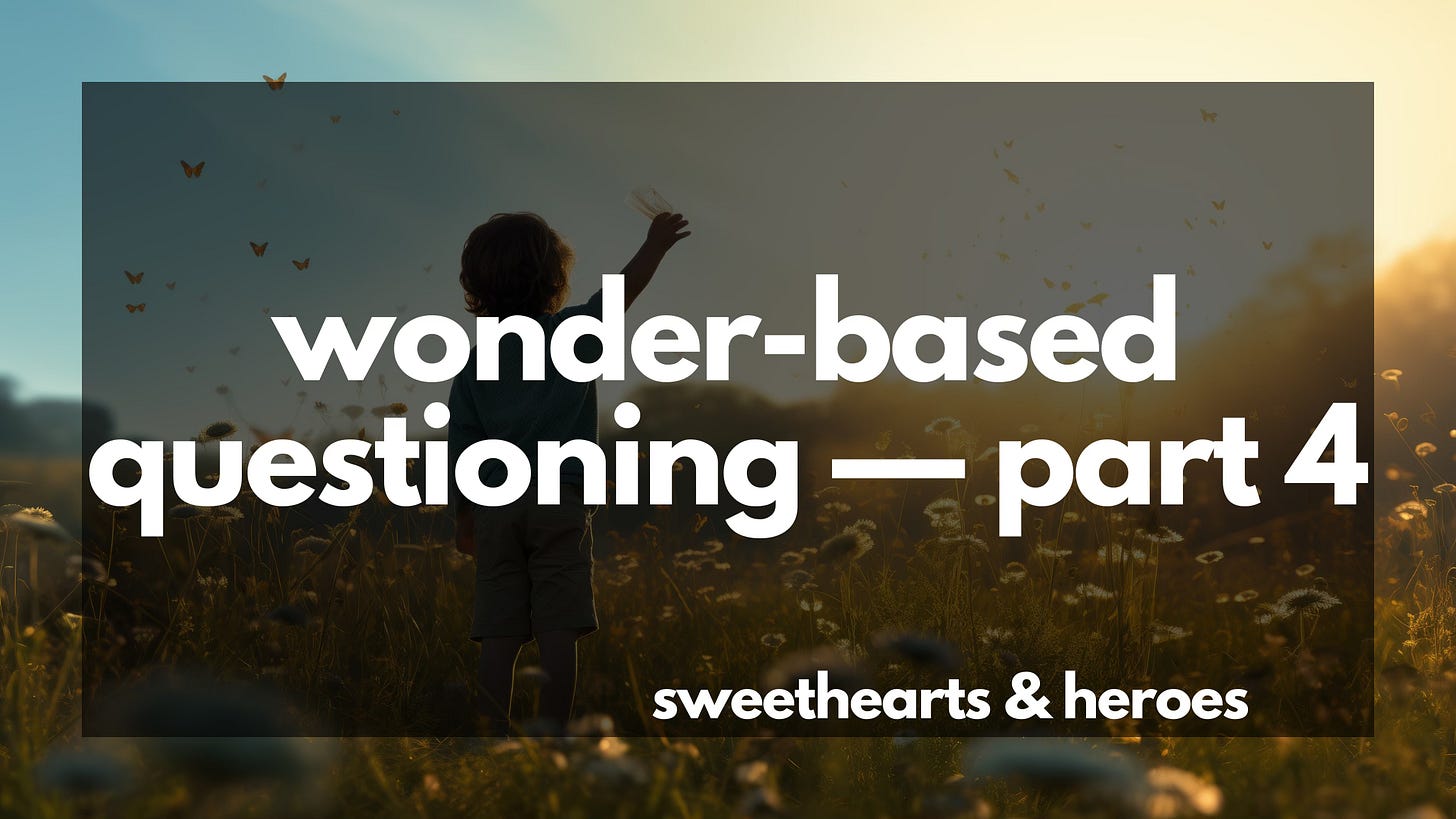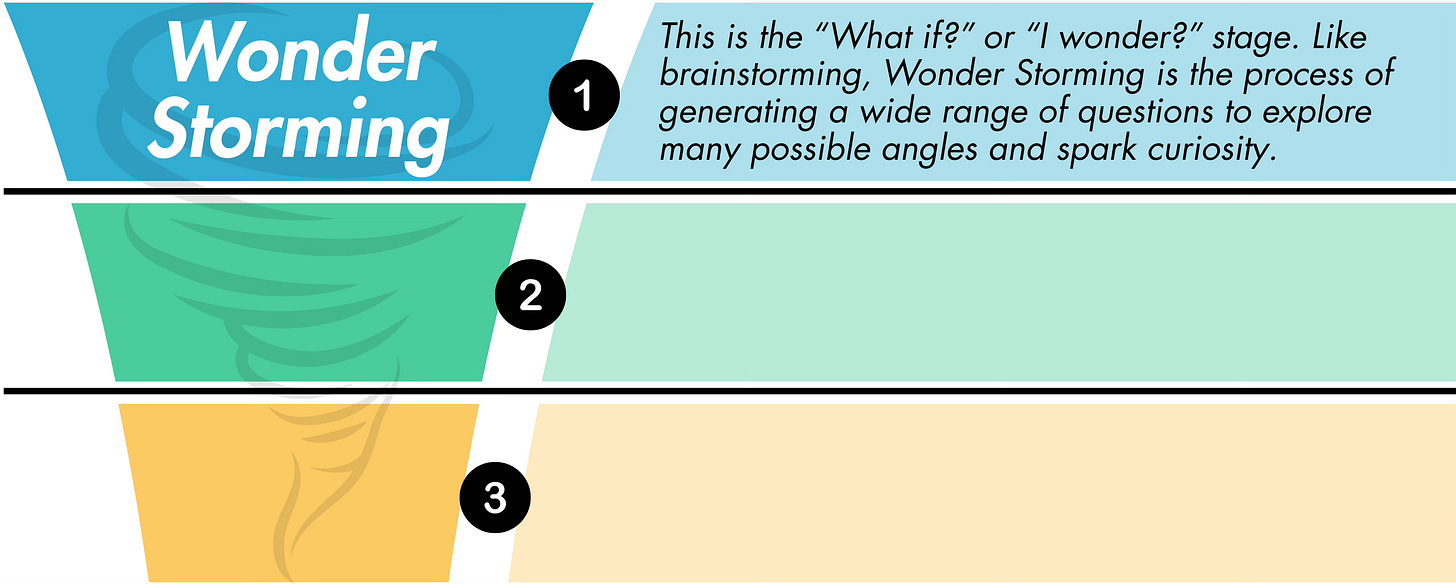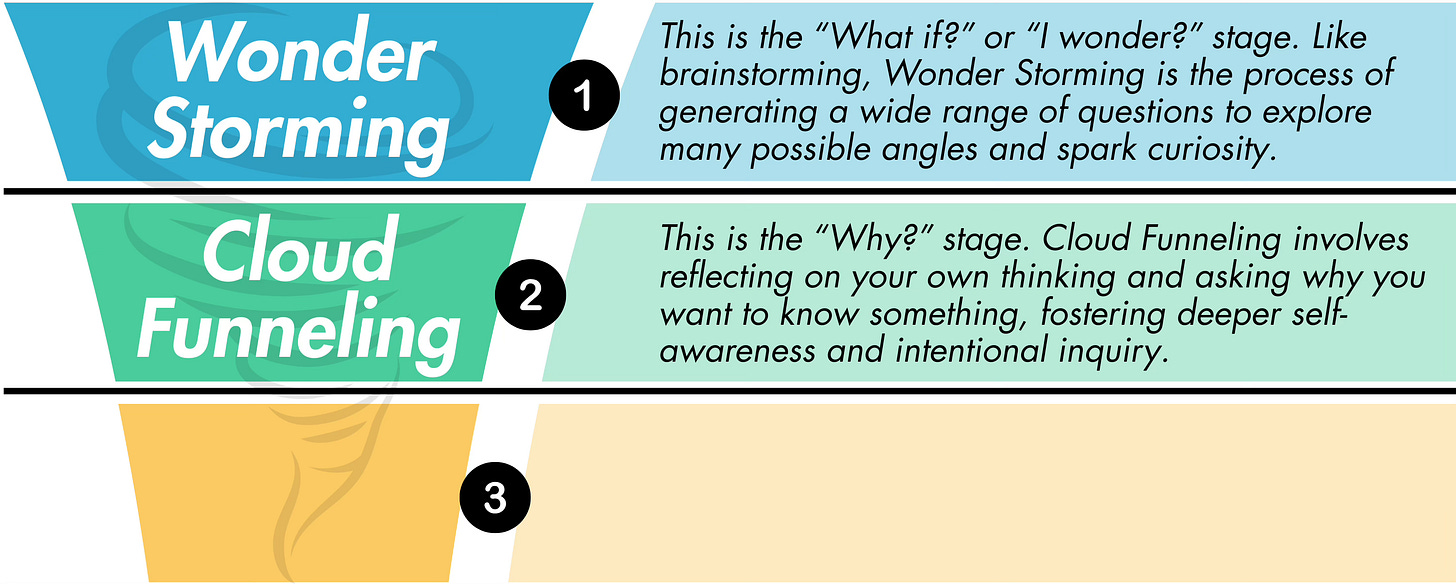Wonder-Based Questioning - Part 4
Our articles often contain unconventional ideas inspired by the young people and amazing educators we have met. These are not intended to offend, but rather to spark curiosity and inspire contemplation. We do not claim these views as truths, merely one point of view. If these ideas challenge or offend you, we invite you to engage with them critically and share your thoughts with us.
Welcome back to our Wonder-Based Questioning Series, where we explore inquiry-driven education by empowering students with our Wonder Question Technique (WQT). If you missed it:
Read Part 1 here!
Read Part 2 here!
Read Part 3 here!
Wonder Storming Recap
Here’s a quick recap of what we’ve covered in Part 3.
We started with the understanding that our work builds from a strength-based (rather than deficit-based) approach. We’ve partnered with Thrively because we believe they are at the cutting edge of merging technology, education, and student well-being.
Thrively’s system nurtures the whole student. It fosters self-discovery through personalized learning paths. Simultaneously, we deliver foundational human skill programs and courses, and you can follow your students’ learning journey as it builds their “graduation portraits.”
We then explored divergent questioning or “Wonder Storming.” This is where students generate “What if?” or “I wonder if?” type questions to spark curiosity individually and, when secure enough, build emotional intelligence and trust in groups.
Step 2 — “Why?” Stage — Cloud Funneling
The Wonder Storming process is intended to produce a variety of questions from each student. Here, we diverge from the traditional QFT process.
In the QFT model, they begin with divergent thinking (brainstorming) and then shift to convergent thinking (improving and prioritizing). Only then do they move into metacognitive thinking, where they think about the process that unfolded.
Instead of shifting directly from divergent to convergent questions, we want to pause here and reflect on why we asked certain questions. This is the self-awareness piece of the WQT, and self-awareness is the essential foundation for developing all other human skills. You can't work toward improvement if you’re unaware of who you are and how you behave.
There may be many questions we can’t evaluate due to time constraints, and there will be others we aren’t interested in pursuing further. Instead, focus on the questions that interest you the most and ask yourself, “Why did you ask this?”
This is how we narrow down the quantity of questions to search for the questions we find (from our point of view) to be the ones we are curious about the most.
We call this process Cloud Funneling.
This is the central vortex of the tornado through which the questions are channeled downward toward the touch point or convergence. This vortex is an amalgamation of your different thoughts and questions. Here, we look at these raw and unfiltered “clouds” and self-reflect to understand what we seek.
Returning to the writer working through writer’s block, not all your thoughts and questions will be ringers. There is a lot of dust and debris flying around. The goal is to siphon them based on our internal criteria and look for those questions that light up our Wonder Beams the most.
These are the needles in the haystacks; the pure water droplets within the spiraling chaos of the storm.
Asking “Why?”
The key question for this stage is “Why do you want to ask this (or that) question?”
However, we must be very delicate with this “why?” question process.
Asking “why?” is an inherently human thing to do.
We were born to ask “why?”
Asking “why?” is the basis of our Wonder Beams!
However, we avoid directly asking kids “why?” questions when possible. Of course, we cannot avoid this every time, but unfortunately, adults often meet these “why?” questions from kids with a sense of frustration or even annoyance.
This will kill our Wonder Beams almost instantly.
Thus, these “why?” questions have been linked to a subconscious trigger in many of us that shuts down thinking.
When we were children and we did something our parents, caregivers, or other adults disagreed with, they usually asked us, “Why did you do this?”
It was accusatory and can instantly make us think we are being judged, ridiculed, or disciplined. We get defensive and often bury the truth or an honest answer for one we believe those who question us seek.
So, we must approach the “why?” phase of WQT differently.
Instead of posing the question to the student, “Why did you ask this question?” or “Why do you want to know this answer?” we instead turn the question itself into a statement of guidance or instruction:
Reflect and ask YOURSELF why you are asking these questions.
Boom.
Game-changer.
Here, there is much less of an imperative to defend your thoughts.
Instead of the educators presenting the “why?” question to learn how a student is thinking (which, of course, we want to know), we are getting them to ask themselves, “Why am I asking this?” and “What is it I want to know?”
This is the metacognitive, self-reflective piece of the WQT. It allows students to practice asking themselves about their thoughts and feelings, helping them build self-management and responsible decision-making skills for the future. It’s difficult to pause in the middle of a situation and ask yourself why you are feeling or behaving a certain way. It takes practice, just like any other ability.
This process can be challenging.
Most individuals (especially young people) have likely never asked themselves “why?” like this. Initially, we may not even be able to provide much of an answer.
But humans don’t randomly ask questions.
They don’t just manifest out of thin air.
Our questions are communicating something.
Just as behavior is a form of communication, this stage is about digging to the root of your curiosity. What seeds have been planted in your mind that sprouted this wonder? What are you trying to understand? What do you need to know about yourself? About your human condition?
It’s important to note that the reasons don’t need to be complex if they aren’t.
If a student wants to ask a question because they’ve always wanted to ask that question, that’s a reason! Their intentions with a question don’t need to include these massive justifications. Curiosity and wonder alone are good answers to why we want to know something.
Again, most students will probably not have an answer when completing this process for the first, second, or even third time. But as you work on the WQT more and more, this self-reflection will begin to run automatically as students think of questions.
Cloud Funneling and Emotional Intelligence
As we move into the “why?” stage, the process naturally turns toward self-awareness and self-reflection. Again, we always recommend you start here with students who haven’t experienced WQT and for groups that haven’t built that familiarity.
Thrively facilitates this entire process, which can be done individually or as a group. This is an equally potent social awareness practice.
Metacognitive questioning in a group builds social awareness as students share and listen to each other’s reasons for asking specific questions. Students practice empathy, active listening, and perspective-taking by discussing their “why?” in a secure, non-judgmental group setting, strengthening relationship skills.
WQT also promotes self-management and responsible decision-making, as students consider how others perceive their questions and contributions. This fosters a deeper understanding of group dynamics and enhances their ability to navigate social interactions with intention and care.
The more students work through this process, the more they’ll begin to learn what questions they want to ask based on the answers they hope to garner.
If you understand why you want to know something, you might want to ask a different or better question. Doing this as a group simultaneously lends your courage to others when you ask difficult questions, letting them know it’s okay to ask questions that may be uncomfortable or make us appear foolish.
Luke, Tessa, Eleanor, and Brady
In the last article, we set the stage with a prompt.
To picture this prompt or Central Focus, imagine it as a tornado that provides the frame to channel our thoughts and Wonder Beams.
Here is the prompt from Part 3:
What do you wonder about Mahatma Gandhi’s travels across India and the world?
As mentioned, this phrasing is optional, but “What do you wonder about…” adds that element of possibility and awe.
Let’s reintroduce our example team: Luke, Tessa, Eleanor, and Brady.
Remember, Wonder Storming is designed to generate many questions from each student. In this example, these are the questions each student asked and is interested in pursuing the most:
Luke’s selected question is: “I wonder if he was a minimalist?”
Tessa’s is: “I wonder how many families he stayed with?”
Eleanor’s: “I wonder how long he traveled for?”
Brady’s: “I wonder if he rode a camel?”
As the group goes around providing their selected question, they should also be encouraged to share why the question interests them the most.
We’ll start with Luke.
As a kid, Luke’s grandfather took him on trips to historical sites, telling him stories from the past. Luke was often more interested in his phone or the gift shop than the monuments or history. Now that his grandfather has passed, he thinks about being more present during their time together.
Eleanor is also reminded of time. She is an elderly woman living in a nursing home. Thinking back on life, she’s often surprised by how quickly time passes. Dedicating one’s time to life on the road and away from home is probably tough.
Speaking of home, Tessa is a new mother. She’s starting a family, and it seems like such a foreign idea today to welcome strangers into your home.
And then there’s Brady’s question about the camel.
Frankly, Brady was just wondering that, and that’s okay.
Does that make it one of those junk questions?
The dust and debris you’re filtering out as you identify the important ones?
Maybe.
But there is one last step to the Wonder Question Technique that might provide a bit more enlightenment and spark the origin of “why?” in Brady’s mind.
This step leads us to a place where all our Wonder Beams can collide in a prism of synergy. We call this convergence our Apex Questions: questions that touch a common core thread of wonder in us all.





